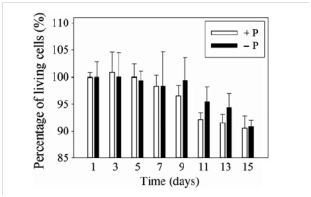作 者:Huang, XZ;Huang, BQ; Chen, JX; Liu, X影响因子:2.273
刊物名称:JOURNAL OF PLANKTON RESEARCH
出版年份:2016
卷:38 页码: 83-93
Prorocentrum donghaienseLu is a typical harmful algal species in the East China Sea, which has already had significant influences on ecosystems as well as caused economic losses over the past two decades. This study focused on cellular responses to phosphate limitation and chronological ageing forP. donghaiense. Results showed that reactive oxygen species (ROS) production, caspase-like activity and a metacaspase gene expression were significantly higher in the phosphate deplete treatment than in the phosphate replete treatment while algal cell death was not associated with caspase-like activity, and the test alga still grew with low photosynthetic efficiency in the phosphate-limited culture. Our results indicate that ROS production played multiple roles in the chronological ageing and regulation stress signalling or/and cell death inP. donghaiense. Metacaspase and caspase-like enzymes not only played a programmed cell death (PCD)-specific role (caused cell death) but also linked with chronological ageing of cultures and acclimation (survival) for phosphate limitation. It also demonstrated that classical hallmarks of PCD (such as cleavage of caspase substrates) for metazoa might be not suitable for characterization of PCD pathways in phytoplankton. This study provides a novel insight into whyP. donghaienseblooms can persist for a long period with high abundance.

Fig. 2.Percentage of living cells ofProrocentrum donghaienseLu during a 15-day batch culture with phosphate replete treatment (+P) and phosphate deplete treatment (-P). Error bars represent the standard deviation of triplicate cultures.

